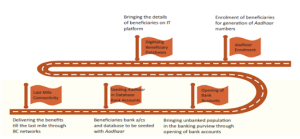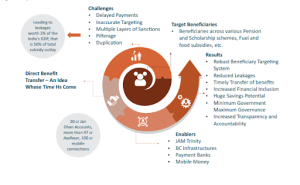19 Oct How Direct Benefit Transfer scheme has transformed social welfare in India
Direct Benefit Transfer
The article talks about how How Direct Benefit Transfer scheme has transformed social welfare in India. It is based on Economic and Social Development.
CONTEXT
Last week, India got global laurel when the IMF appreciated the Direct Benefit Transfer (DBT) Scheme of the Government of India and called it a ‘logistical marvel’. David Malpass, President of the World Bank Group, also gave a call to other countries to adopt India’s move of targeted cash transfer instead of broad subsidies stating that “India managed to provide food or cash support to a remarkable 85 percent of rural households and 69 percent of urban households”.
WHAT IS THE DIRECT BENEFIT TRANSFER (DBT) SCHEME
- The DBT scheme was introduced in 2013 to improve the Government’s delivery system in welfare schemes by making the flow of funds and information faster, and more secure and reducing leakages.
- It transfers subsidies and cash benefits directly to the people through their Aadhar-seeded bank accounts instead of transferring them to the Government offices.
- Aadhar serves as the backbone of the scheme though it is not mandatory for the scheme
- It operates in two ways- cash transfer or in-kind transfer.
- In in-kind transfers, benefits are given by the Government to individuals through an intermediate agency that procures the goods for public distribution and makes them available to the beneficiary for free or at subsidized rates. The biggest example of this is the Public Distribution System (PDS)
- The other way is cash transfers. Under this, cash benefits are transferred by the Government to individual beneficiaries. Examples of cash transfers include the PAHAL scheme wherein subsidized liquefied petroleum gas (LPG) cylinders are sold at market rates to the consumers who receive LPG subsidies directly into their bank accounts. Another case of cash transfer is the MGNREGA scheme.
- The Office of the Controller General of Accounts’ Central Plan Scheme Monitoring System (CPSMS) serves as a common platform for routing DBT. It prepares the list of beneficiaries and processes payments in the account of the beneficiary Aadhaar Payment Bridge.
REQUIREMENTS FOR DIRECT BENEFIT TRANSFER

REQUIREMENTS FOR DBT SCHEME
ENABLERS OF THE DBT SCHEME
- JAM Trinity: JAM trinity means linking the Jan Dhan accounts, mobile numbers, and Aadhaar cards of people. This ensures proper targeting, elimination of frauds and ghost accounts and that money reaches the intended beneficiary.
- Business Correspondents Infrastructure: Business Correspondents are retail agents employed by banks for providing banking services at locations other than a bank branch/ATM.
- Payments Bank: Payment banks were created for furthering financial inclusion by enabling the transfer of money through mobile phones. They cannot issue loans or credit cards. Payment banks help to spread financial services to low-income households and small businesses as well as migrant workers. It operates in a secure technology-driven manner.
- Mobile money: Mobile money refers to financial transactions and services that can be carried out using a mobile device such as a mobile phone or tablet.
BENEFITS OF DBT

Pic: BENEFITS OF DBT
- The DBT has proved to be an ambitious and well-structured financial inclusion program that has been working to include all households within the fold of the formal financial network
- Today, it has 318 schemes of 53 central ministries spanning different sectors, covering the vast geography of the country.
- DBT has helped to remove leakages, ghosts, or fake accounts and transfer funds to the genuine beneficiary.
- It has helped farmers tremendously by lowering the input costs on fertilizers and irrigation through programs like PM Kisan Samman Nidhi, and PM Krishi Sinchayi Yojana
- DBT has enabled social security in the nation through various scholarship schemes and the National Social Assistance Programme
- It increases transparency in the system and the incidents of theft and loss of public resources.
CHALLENGES IN DBT
- Digital illiteracy: a large proportion of people in rural areas lack the digital literacy needed for the smooth working of DBT
- Exclusion: Aadhar registrations presently cover around 91% of the population. Since DBT is linked with Aadhar for the majority of the schemes, there is a need to improve Aadhar linkage to 100% so that no one is left out.
- Duplication: a recent Comptroller and Auditor General of India (CAG) audit on the functioning of the Unique Identification Authority of India (UIDAI) revealed that the Aadhaar database may contain identical biometric data for multiple citizens. This leads to duplication and crediting wrong accounts.
WAY AHEAD
Despite the big population and vast size of the country, DBT has proved to be efficient in targeting the intended beneficiaries and ensuring welfare through financial support. It is expected to scale up further and improve the ease of living for people. However, digital and financial literacy, robust grievance redressal, enhancing awareness, and an empowering innovation system are some of the aspects that would require continued focus. This would ensure inclusive growth and development of the people and the nation.
SOURCES
Download PDF
Download Plutus IAS current affairs 19th Oct 2022
Daily Current Affairs for UPSC
Are you looking for the latest Daily Current Affairs for UPSC Examination? The topic described above is related to Economic & Social Development. Nowadays it is very important for any UPSC aspirant to reading Current Affairs for UPSC examination. So everybody should accustom to reading Current Affairs for UPSC examination. Plutus IAS gives the precis of all of the applicable information of the day. These precise are concise and different critical facts, data, examples, instances, and many others are integrated apart from what’s included in the information in order that one receives each record relating to the exam. You could make notes of those and revise them periodically for smooth memorization. Reading that day by day additionally enables you in growing an addiction day by day studying to help you save the ultimate minute rush of study.



No Comments